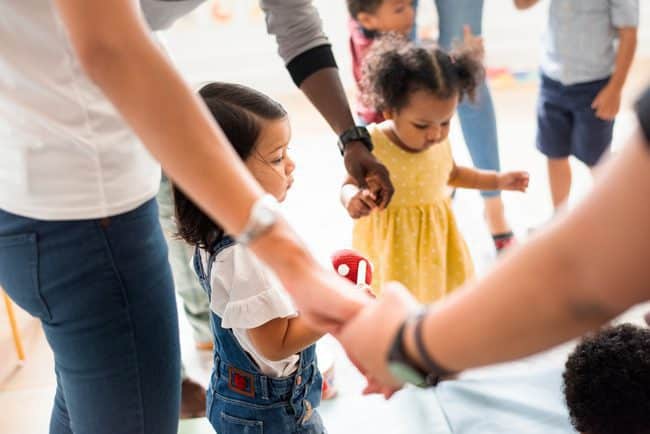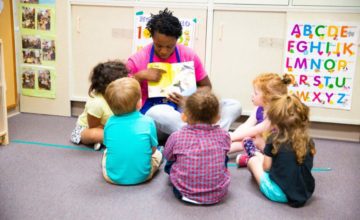What do young children understand about their identity? How can parents help them construct a positive self-identity? Read on for tips and tools.
Self-Identity
One of the first steps toward developing a self-identity comes at about 18 months when toddlers are able to first recognize themselves in a mirror. Another milestone you might notice is your child referring to herself in the third person, “Erin doesn’t want a nap!” Understanding that they are their own, separate person also means that toddlers begin using their favorite pronouns: “me,” “my,” and “mine.” (So while these moments of self-declared ownership are not always easy, the upside is that your toddler definitely knows who he is!)
Gender Identity
By about age 2-2 ½, children have begun to internalize messages about gender and begin to identify as a boy or a girl. They may have strict rules (and even take great pride) about what they wear or do to be consistent with their emerging gender identity. (You’ll see these “rules” soften over time as children who are exposed to various toys and experiences will naturally gravitate to those they find most interesting.) As children approach age three, they start to notice the gender of others. This is the moment when you’ll hear every parent’s favorite question in the deli line at the supermarket, “IS THAT PERSON A BOY OR A GIRL?”
Racial Identity
Racial identity is also emerging during the second year. Children first learn that their skin color makes a difference by seeing and experiencing “how they are treated, and how they are ‘like’ others with the same skin color.” Between ages 3 and 4, children are able to identify and match people according to physical characteristics like race, but are still unclear about whether these characteristics are permanent (“will I always have my skin color?”). This is also when children first begin to absorb and respond to stereotypes (racial, gender, and other). Through daily life in their communities, children are exposed to many messages about whether people with their skin color are perceived as valued, respected, and powerful. Parents can help their children build a positive sense of self by affirming their strengths and abilities, and by sharing family stories, values, and traditions. Racial and ethnic identify can also be nurtured through books, toys, play, and cultural experiences.

Using Stories to Nurture Identity
Sharing stories is a great way to help children learn more about themselves and the world around them. As you check out the booklist below, use these books as a jumping off point for what will be a lifetime of conversations about who your child is—and who you are as a family. Here are six tips for rich conversations, starting early.
- Make connections between the story and your child’s life. If you’re reading I Love My Hair! (see below), you can talk about your daily routine of combing hair, how you are helping your child, and how your mother helped you.
- Choose stories with diverse characters. Research shows that the majority of children’s books with human characters feature white children and families (one review
 found that only 3% of children’s books featured African-American characters with other races/ethnicities represented even more rarely). Offering a diverse outlook on the world through stories gives children of color the chance to see themselves in books—and for all children, is a powerful way of challenging racial stereotypes from the start. Use the Diverse Book Finder to discover new gems.
found that only 3% of children’s books featured African-American characters with other races/ethnicities represented even more rarely). Offering a diverse outlook on the world through stories gives children of color the chance to see themselves in books—and for all children, is a powerful way of challenging racial stereotypes from the start. Use the Diverse Book Finder to discover new gems. - Give your child a chance to share his perspective. As you read Julián Is a Mermaid, you will discover the main character loves everything about mermaids. You can help children begin to understand that there are many ways to express themselves: Julián likes mermaids. Do you like mermaids? What else do you like?
- As you share stories, focus on what’s the same, not just what’s different. When we share a story about a family or culture that’s different from ours, it’s natural to focus on what’s new and interesting. But it’s equally important to help children notice what’s the same across cultures and communities—all families love one another, all children like to play, etc.
- Give your child a chance to predict what will happen next, or what they would do in the story. Younger toddlers (3 – 3 ½ ) are starting to make predictions from the pictures in their storybooks. When you turn to a new page, you can ask your child: “Look at the pictures…what do you think is going to happen?” By the time children are 4-5 years old, they can understand the dilemma in the story and imagine their own response.
- Make the connection to your family values and beliefs. Children’s books present many opportunities to talk about the kind of person you want your child to be and what qualities you and your family value. Notice and point out these elements in the stories you read together. But most importantly, live them in the interactions you share with your child. Offering children access to a supportive, diverse community is the best way to model inclusiveness.
A (Not Exclusive) Booklist for Nurturing Identity
- Racial Identity
- Skin Again by bell hooks
- The Colors of Us by Karen Katz
- Happy In Our Skin by Fran Manushkin
- I Love My Hair! by Natasha Anastasia Tarpley
- The Skin You Live In by Michael Tyler
- Gender Identity
- My Princess Boy by Cheryl Kilodavis
- Julián Is a Mermaid by Jessica Love
- Jack (Not Jackie) by Erica Silverman
- Accepting Differences
- Whoever You Are by Mem Fox
- One Love by Cedella Marley
- It’s Okay to Be Different by Todd Parr
- One Family by George Shannon
- Hot Pot Night! By Vincent Chen
This article is part of a series on Parenting for Social Justice. For more, visit zerotothree.org/parentingforsocialjustice.



